Denali, on the Ground
Everest is higher. Almost 50% higher. But Everest sits on a 19,000-foot Tibetan plateau, and it is surrounded by peaks nearly its own height. It actually can be hard to spot Everest from some angles.
Contrastingly, Denali rests on a low base of only 2,000 feet. The massif rises nearly 18,000 feet above its foundation, nearly twice the rise of Everest’s 10,000-foot bump. Here is the wikipedia graphic:
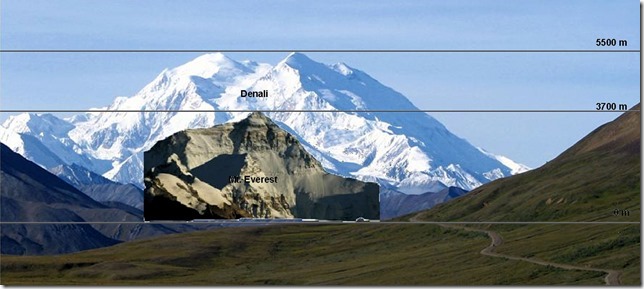
Denali is quite noticeable, and worthy of its appellation: The High One. Dominating the landscape much like Fujimoto or Kilimanjaro, Denali is THERE, in your face, and not cloaked in its own mountain range like Whitney or Everest. There are other differences – Denali is the world’s only high peak in a polar region, with all other tall mountains much closer to the equator. Even Aconcagua, in the Argentinian Andes, is only 32 degrees away from the equator (Denali is at 63 North!). It’s cold up there, even in the summer. A record wind-chill of –148F was recorded one winter, with typical wind-chill temps in the –110-120F range. Like other big ascents, Denali also makes its own weather, making forecasting equivalent to dart-throwing. And to top it off (no pun intended), there’s actually less oxygen at any given altitude on Denali, due to the thinner troposphere (lower air density) toward Earth’s poles. These distinctions make Denali an easy choice for one of the greater alpine challenges. In addition, of course, it’s the tallest peak in North America, so it’s forever on the “big seven” world summits list.
All that said, Denali does have a “reasonable” summit-attempt success rate, at about 50%. Everest’s is 29%. The majority (85%) of Denali climbs start from the 7,900-foot base camp on the glacier, which helps the success rate. But it’s still only one of two attempts. The weather is simply brutal. It is quite common for ascent teams to simply run out of food while waiting for the weather to improve enough to support a summit attack.
Suffice it to say, we had absolutely nothing to do with climbing the mountain. I include all this data here just as interesting info about a fascinating place. There are many volumes written about Denali, and far more information than I’m going to share in this post.
We got into the Park on the most fantastic stroke of luck we may yet have had on this trip (besides no flat tires on the Dempster!). Frankly, we were not expecting to be able to stay in the Park. It is 100% reservation-only, it has the reputation of booking up months in advance, which we had verified, and we were simply going camp somewhere outside and take the bus ride in. But, as our good fortune would have it, a last-minute check of availability showed a 4-day window at Teklanika, the deepest RV camp in the Park, 30 miles in from the highway. We grabbed it, and spent the next hour congratulating ourselves.
Arriving at the Park (about 125 miles south of Fairbanks), we checked in, got our reserved-site tags, congratulated ourselves again, and trekked out the park road for the 30 miles.
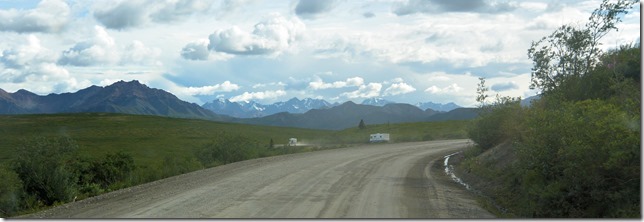
We were not disappointed. It was big, it was wild, it was beautiful. We drove slow.
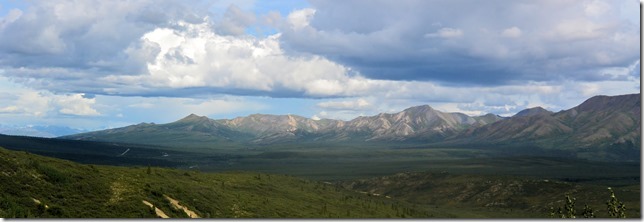
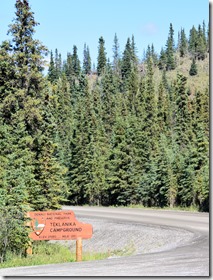 Denali can’t be viewed until about 45 miles into the Park, so we contented ourselves with the lower parts of the range and the vast space before us. “Tek” camp is right on its namesake river and we settled in.
Denali can’t be viewed until about 45 miles into the Park, so we contented ourselves with the lower parts of the range and the vast space before us. “Tek” camp is right on its namesake river and we settled in.
Our only real tactical error came on our first full day. It was a dark and rainy time, and we had no expectations of seeing the Mountain. But we were eager to experience the Park, and we knew that the animals would be out foraging regardless of weather. So we hopped onto the shuttle for the six-hour (round trip) ride out to Eielson and its well-reviewed visitor center. Big mistake.
At first, we were pretty excited, and a grizzly was spotted only 30 minutes after leaving camp. He was far away, across the river, and hard to photograph. But in the binoculars, he was still impressive.
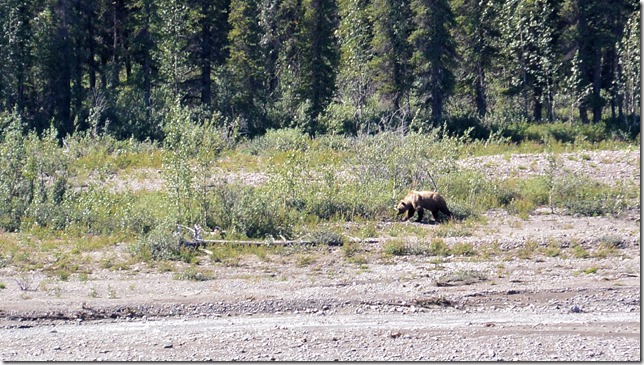
But once the rain settled in, the normally dusty road became covered with a thin, wet dust – we call this “mud”. Even at our average speed of 10-15mph, the watery mud sprayed enthusiastically up off the big bus tires and quickly coated all the side windows with a gray-brown film. We’d clean them up, sort of, at a rest stop, and in less than a mile, we’d again be riding inside a wet brown paper bag. The only visibility was either through the rain-spotted windshield, or when a side window was briefly lowered – for the rain to pour in.
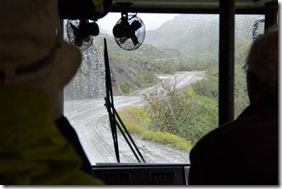
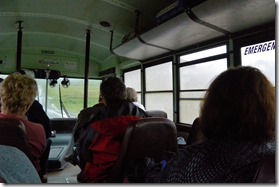
Oh, there were a few times when we spotted some caribou on the lee side, and could open some windows without getting a shower. But in general, the day was a bit of a bust.
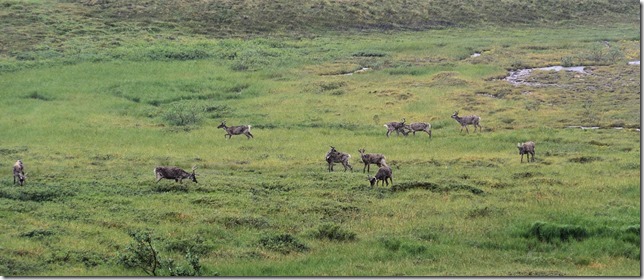
Still and all, we became keenly aware of the size and scope of the Park. Our three-hour one-way drive took us 30 miles, less than one-third of the full distance along the access road. On either side of us the entire way, there was – – – wilderness. Pure, bare, un-blemished wild land, and lots of it. The Park is presently over six million acres, roughly 10,000 square miles. That’s about the same size as the entire state of Vermont. And, except for some access roads at the entrance, there is one single 92-mile road in the entire Park.
We became even more aware of our fabulous luck in being able to camp inside the Park, and 30 miles inside at that. Otherwise, we would have been restricted to the LONG bus rides, which average only 10-15 miles per hour. Being in camp let us attend some Ranger programs too, always an educational treat.
The weather forecast (hahahaha it’s commonly considered a joke) was calling for a clearing trend, with sun two days away. But the very next morning dawned a gorgeous sky with great promise, so we again “seized the day” and caught a bus. No rain, no mud, great views. This time, we elected for a shorter ride to a hiking area, for once again we had no expectation for adequate visibility across the 45 miles to the Mountain.
Amazingly, the big beast decided to give us a tantalizing glimpse. Making its own weather, Denali shyly covered its head and neck in a cloudy shawl. We got just a brief peek at its shoulders for a few minutes, and the weather once again pulled closely around the Mountain and fully clothed it.
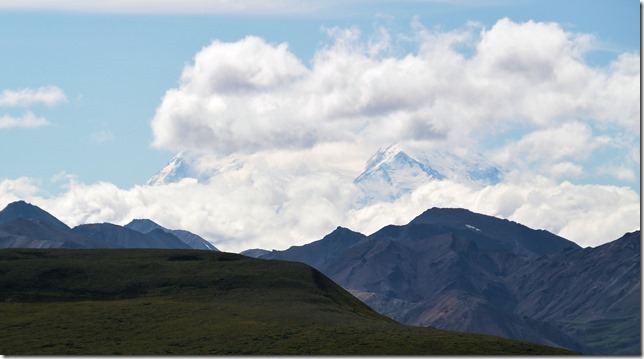
The day was clear and gorgeous, and we bused out along the skinny but not-too-dusty park road, following the long traverse up the Polychrome climb.
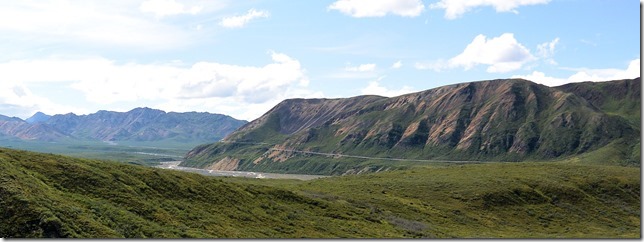
Getting off the bus at the overlook, we were able to appreciate some of the grandness of the Park, even without the dominance of Denali in any background. It’s a huge, beautifully lonely place, and the mountains and valleys lend a wonderful sense of dimension to the thousands of square miles of space. We had similar space around us ‘way up on the northern tundra, but it was hard to see it or feel it, even from an aircraft. Here, it rivets our attention from any direction.
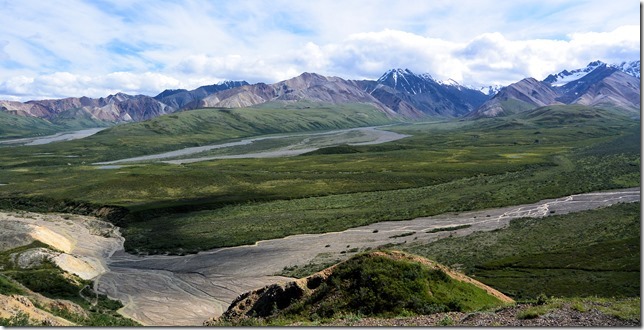
Across from the road, we hiked up over a rise and into Never-never-land. We could hardly believe that “civilization” existed behind us, but for a scraggly little path that quickly became little more than a game trail.
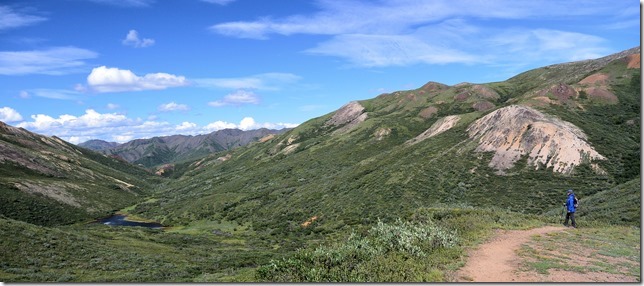
As we climbed the trail and topped a rise, the distant valley came into sight, from a rare level spot in the trail. Here in this harsh countryside, the tree line is at only 3,000 feet. We are just above it, and our views are unimpeded.
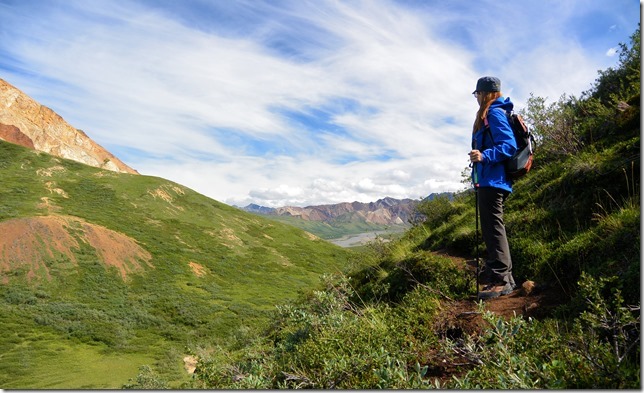
We hiked down to the tiny pond in the near valley – – – or rather I should say “toward” it. The ground became very boggy and muddy, and we would have been hip-deep by the time we reached the pond. No percentage in that. So we went sideways and bush-whacked back up the hill, paralleling the road, sometimes having to tunnel under willow thickets. Let me tell you, the big piles of moose droppings we passed, while we were crouched over in the under-brush, did not go un-noticed by us. There are far more back-country incidents from moose than from bears in the North. Bears are pretty predictable and will generally avoid humans (especially in Denali). Moose, on the other hand, will avoid people one day and charge and stomp them the next.
Well, no moose (or bears) showed up, and we got out of the thicket, topped the hill, and then decided to walk the road for a few miles before catching the bus back to camp.
One of the deepest beauties of the Park is an unusual one: in most areas of the Park, a visitor is allowed unlimited “off trail” privileges. Unlike other more regimented parks, Denali allows “social trails” of opportunity, where you can literally just strike out across the tundra or forest in any direction that catches your fancy.
What this empowers is a deep and abiding sense of what the original explorers encountered in their treks through the region. Walking a typical established trail is straightforward, even for a strenuous hike. Few decisions need to be made, and not a lot of underbrush and obstacles are in the way most of the time. You have a reasonable expectation that the trail goes somewhere, and back-tracking is not often needed. But “brush-bucking”, or “bush-whacking” as it’s sometimes called, is completely different. There’s no trail – you’re making it up as you go. You might get to where you want to go, and you just might have to start over from the beginning. You have to step, jump, climb, or crawl over every dang piece of brush, willow outcropping, dense thicket, mud, or other obstacle that comes your way, and you have to figure out the route to get you past it with every step you take.
One expert estimates that a seasoned back-country hiker, who might manage 12-20 miles on any ordinary hike, could end up fully exhausted after only 5 miles of trekking across trackless Denali back-country.
But it is only by walking that you place yourself at the behest of the land. Only by walking can you feel that intimacy of contact, and its attendant vulnerability. So, walk we do, as much and wherever we can, even though it’s more work for our 70-year-old bodies than it was a decade or two ago. It is always worth it.
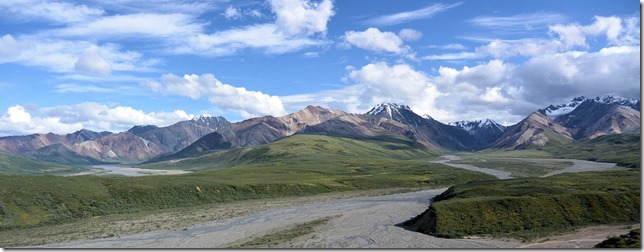
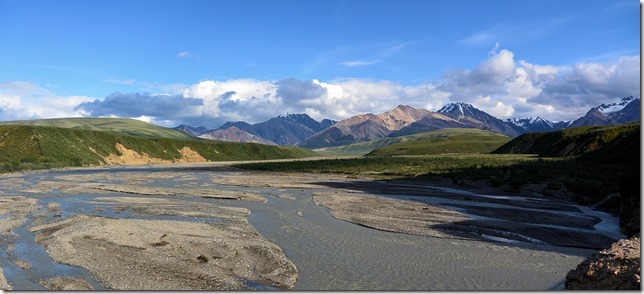
This day, we had hiked a little over a mile while bush-whacking, and another three miles or so before flagging down the bus. Even with that little distance, we were beat.
The bus return ride was pleasant (no mud or dust), and fruitful – wildlife was out, and although somewhat far away, still exciting to see. The highlight was without question TWO grizzlies, foraging for roots and berries on a lush hillside.
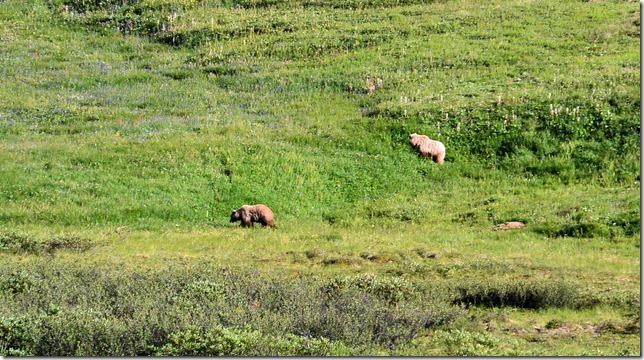
When they got a bit separated by the brush, one of them reared up to get a look around for his missing buddy. My finger just happened to be on the shutter button for that exact second:
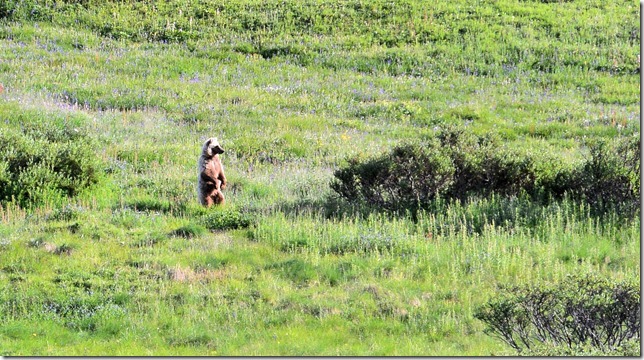
On our last day at Teklanika, the weather once again closed in and filled earth and sky with water. We decided to stay near camp, and explore the nearby river bed and banks – what at first blush appeared to be an easy proposition. Just walk along the gravel between the water — how hard could it get?
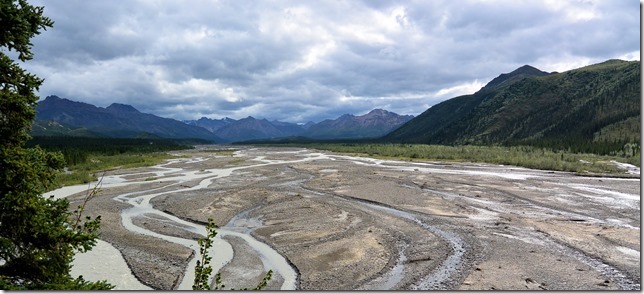
So much for first impressions. These rivers, glacial in origin, are of a configuration I hadn’t heard previously: they are termed “braided” – like the plaits of a girl’s hair, these rivers are composed of multiple rivulets that weave back and forth across the glacial bed. This trait makes them visually distinctive, and also makes them difficult to navigate on foot. The little streams are constantly getting in the way of making upstream or downstream progress; occasionally we could find a crossing, but not always.
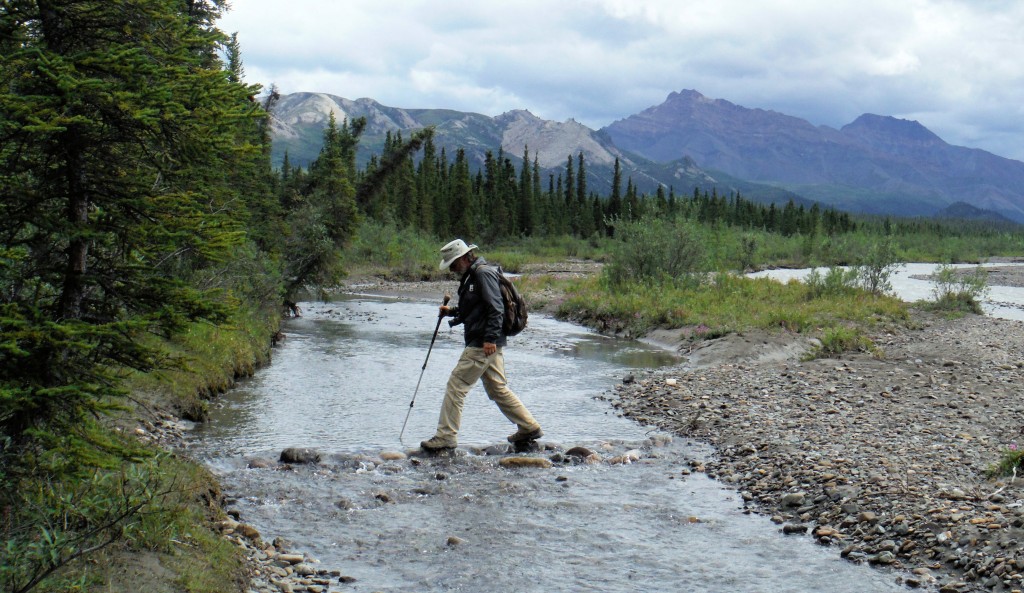
Inevitably, we resorted to traversing the bank of the river. This was not an easy solution either. Here’s where the silty glacial river was joined by a clear mountain stream runoff. Both of them crowded the bank and left us path-less.
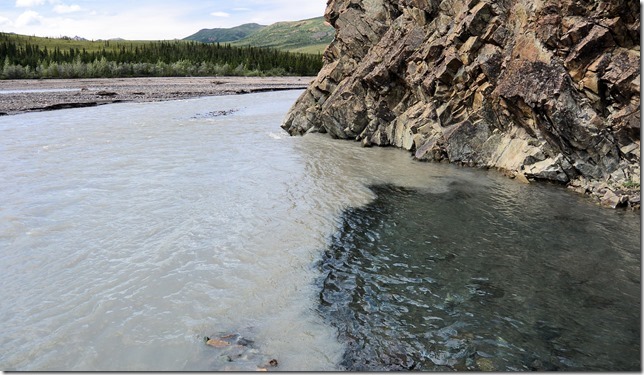
So we climbed up on top and around the rocky point, grabbing branches and poking our staffs into pockets and ledges for a climbing advantage. This little slope was about 70 degrees, and I was almost standing on Karin’s head to take the picture.
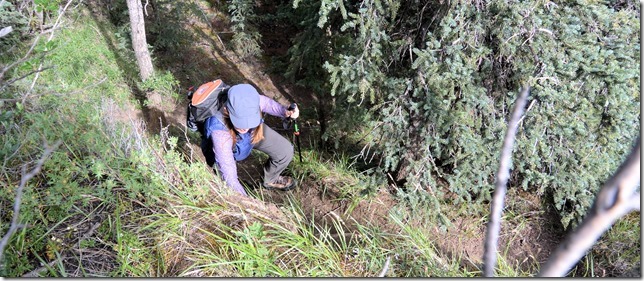
On top, lots of dense brush, with occasional views of the river valley between thickets.
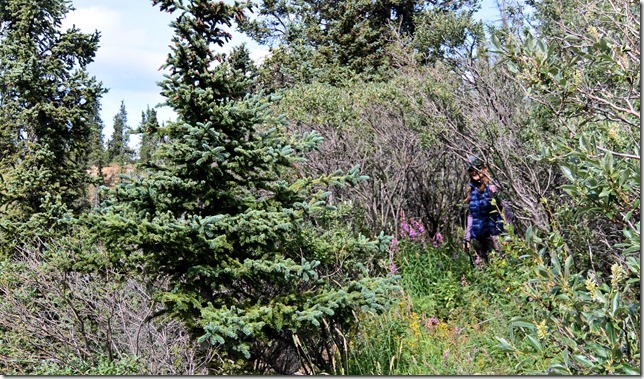
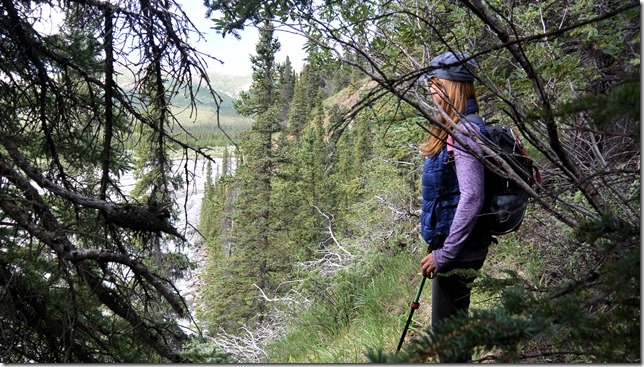
All in all, a great way to get to know more of the Park on our last afternoon.
The next day was even grayer and rainier. Leaving Tek camp, we drove out of the Park, headed for Talkeetna. We got some wifi (after 4 silent days) when we passed the visitor center. Weather forecast was bleak for a few days. We cheerfully picked up Ralph (he was very glad to see us, but didn’t want to show it) and hooked him up behind like usual.
We turned south, and traveled along the highway on endlessly interrupted roads. With the desperately short summer season sponsoring extensive repairs or upgrades, we never saw more than 15-20 miles of pavement at a stretch. Fortunately, the speeds are very slow, and often flag-controlled, one-way — so we didn’t have to deal with giant trucks throwing rocks at us.
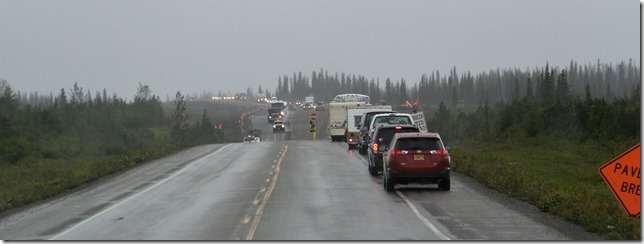
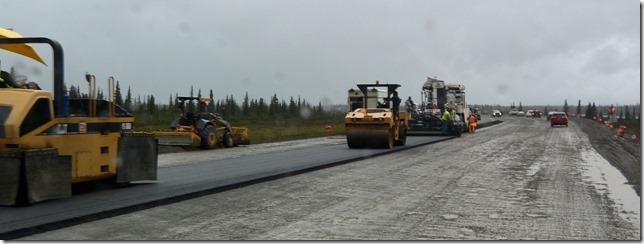
As we traveled north along the turnoff/spur road into Talkeetna, the clearing weather showed us the real Denali, un-cloaked and deservedly proud. It is 55 miles away in this view, and impossibly high into the northern sky.
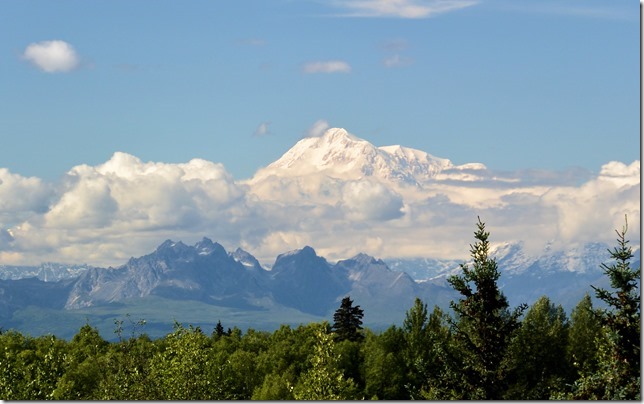
On Monday, we have a sightseeing flight booked, and we’re fervently hoping for good weather. The plan is to actually land on a glacier at the base of Denali. Stay tuned.
- Miles driven (Howie): 5,551
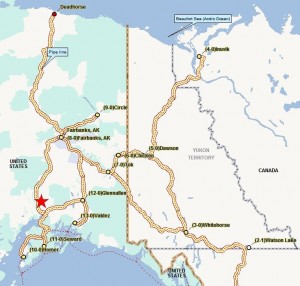
- Miles driven (Ralph): 1,335
- Days traveling: 66
- Miles from home: 3,151

all I can say is “wish I were there” great pics and you are a good writer.publish a book maybe? keep on keepin on—–John L.
John, thanks for the high praise. I’ve thought about writing bigger stuff (books), but I’m enjoying the “photo-journalism” of the blog too much for now. I have an in-law in the publishing business too, but I’m not ready for it (yet).
For those curious…
https://en.m.wikipedia.org/wiki/Denali–Mount_McKinley_naming_dispute
Yeah, I decided not to use up even more space on the whole naming thing. My personal preference is “Denali”, partly because that was its first name, but also because “The Great One” or “The High One” seems to hold for me a greater spiritual content than “A Murdered President”.
I so enjoy reading about your adventure, makes me a bit jealous, but also inspires me to someday have my own adventure.
We felt compelled to follow Nike’s advice (just do it).
Sage words.
:o)